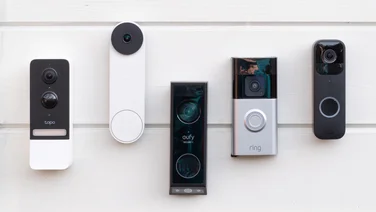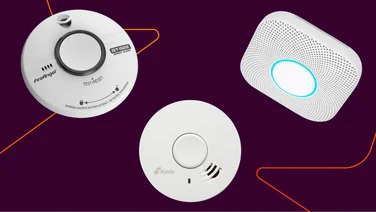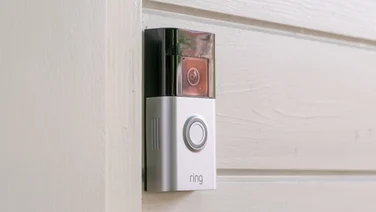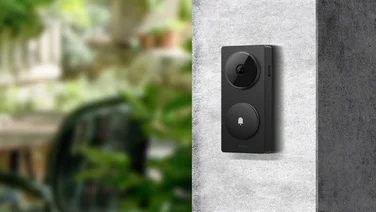To help us provide you with free impartial advice, we may earn a commission if you buy through links on our site. Learn more








- Easy to set up and use
- Two days of local Full HD storage
- No need for a subscription
- Occasional bugs to be ironed out
- Video calls tightly cropped by default
- Chime not included
The Yale Smart Video Doorbell is part of a new collection of smart home products from the British security company that also includes indoor and outdoor cameras. Like many other video doorbells, it has a camera, a microphone and a speaker. It connects to your Wifi network and rings you via the Yale Home smartphone app when a visitor presses the ring button or, optionally, triggers the doorbell’s motion sensor.
Unlike some video doorbells from the big manufacturers, however, there is no requirement for a monthly subscription. As with Yale’s equally new indoor and outdoor security cameras, the doorbell can store around two days’ worth of video recordings locally, ready to be viewed on the app. A £3.50 monthly subscription is available, which adds a couple of extra, AI-powered features and makes recordings available to view online for 30 days, but it is far from required.
With Ring increasing the cost of its subscriptions by 30% in March 2024 – and its video doorbells not storing any video if you don’t pay a fee – Yale’s £130 offering could be just what you’re looking for.
Yale Smart Video Doorbell review: What do you get for your money?
Priced at £130, the Yale video doorbell is more expensive than some alternatives from Ring and Arlo, but it’s cheaper than the Nest Doorbell. Crucially, the Yale doorbell does not lock most of its features behind a subscription, making it better value for money in the long term. The Yale doorbell shares much of its technical specification with the company’s Smart Indoor Camera. This is no bad thing, and it means the doorbell records in Full HD resolution through a 154-degree lens. That’s roughly the same as the 155-degree lens used by older Ring doorbells like the Ring Doorbell 2, though note that video is captured in 16:9 aspect ratio, which isn’t as useful in a doorbell as it is in a security camera as it doesn’t provide a true head-to-toe view.
You do, however, get infrared night vision that switches on and off automatically, a speaker and microphone for two-way audio and all the hardware you need to fit the doorbell to your home. This includes a mounting plate and an optional mounting wedge (for positioning the doorbell at an angle), plus screws, wall plugs and a fuse with wire caps for connecting the doorbell to your existing wiring.
You don’t have to connect it via your old doorbell wiring, but it does mean you can power it from the wiring of your old doorbell instead of the integrated battery.
Just like Yale’s smart indoor and outdoor security cameras, the doorbell has enough internal storage to hold between two and four days’ worth of recordings. 30 days of cloud storage is available via an optional £3.50/mth subscription.








That subscription also gives the doorbell some extra features, including the ability to identify the movement of pets, packages and vehicles, then notify you accordingly. Without a subscription, the video doorbell is still capable of telling humans apart from other types of movement.
Plus, if you also own a compatible Yale smart door lock (like the Conexis L2, Linus or Keyless Connected via a Yale Access Module), you can unlock the door through the same Yale Home app used by the doorbell.
READ NEXT: Best home security systems
Yale Smart Video Doorbell review: What does it do well?
Like other Yale smart home products, the video doorbell is quick and easy to install. It takes just a few minutes to set everything up and either add it to your existing Yale system, or create a new one from scratch using the free Yale Home smartphone app. I particularly like how Yale uses simple, considered language throughout its app, which is something that can’t always be said for products like this.
Physical installation is just like that of other video doorbells. All you need is a drill, a screwdriver and a spirit level to create a pair of level holes and attach the mounting plate to your wall, fence or door.The doorbell itself then attaches to the plate with a locking mechanism that can only be opened with a pin-like tool. One is included in the box, but a smartphone’s SIM tray removal tool will also work.








A neat feature of the Yale doorbell is how it senses when it’s being interfered with, and immediately sends a notification to your phone. I found this happened every time I closely inspected the doorbell, and when I used the tool to remove it from its mounting plate.
Video quality is good and I generally found the doorbell worked well. Pressing the button effectively places a video call, which can be answered in the normal way on your smartphone. My phone usually rang just a couple of seconds after the button was pressed, and the call was connected quickly.








The interface then looks like a video call, but because the doorbell camera’s view is tightly cropped to fill the portrait phone screen, it sometimes makes the visitor hard to see. Helpfully, a tap of a button switches this to an uncropped, landscape view that is much sharper owing to not being zoomed in. Audio quality is fine but nothing to write home about; it’s good enough to have a brief conversation, which is really all you need.
Detection zones and privacy zones can be created, just as they can with other Yale smart security cameras. This system works well and makes it easy to stop the camera being triggered unnecessarily (by a passing car, for example) and to stop it recording anything sensitive, like your neighbours’ doors and windows.








Of course, this only matters if you choose to use the device as a security camera as well as a doorbell. The security camera features can all be disabled if you only want it to function as a video doorbell.
Yale Smart Video Doorbell review: What could it do better?
Setting up the doorbell with my Wi-Fi router went smoothly, just as it did with Yalke’s equally new smart indoor and outdoor security cameras. However, I had a few issues trying to connect the doorbell with a wireless extender, since my router’s coverage doesn’t quite reach the front door.
The solution was to factory reset the doorbell and try again, then again. This kind of process can be a major cause of frustration when building a smart home, since it isn’t always clear what the problem is, or what the solution actually was. Once the Yale doorbell finally connected properly to my extender, I was in business and it worked just fine.








I’ve already explained how the camera crops tightly when placing a video call to your phone. How much this affects your usage will depend on the positioning of your doorbell, and whether you use the included wedge to mount it at an angle, thus bringing a visitor into the centre of the frame. In my case, the doorbell being close to a wall meant visitors tend to stand off-centre. This would be addressed by using the angled mount or by remembering to switch the view from full-screen to uncropped when answering.
On one occasion, the camera’s infrared night vision stayed on when it shouldn’t have. Because this happened during the day, it created video footage that was almost entirely white and largely unusable. This was fixed by rebooting the doorbell via a button on the back, but clearly this wouldn’t be possible if I was away from home.








I’ll file this bug into the same group as those that occasionally cause Yale’s other smart cameras to occasionally stop showing live video in the phone app – and something I hope the company can fix quickly as it builds out its new smart home security system.
Lastly, as is often the case with video doorbells, a chime is not included, and though you can power it via existing doorbell wiring, it won’t ring an existing mechanical chime. The doorbell will alert you via the Yale app and your smart speaker or display, if you have one, but otherwise if you want an audible alert you’ll need to buy Yale’s £30 plug-in chime. It’s worth noting that our favourite video doorbell, the TP-Link Tapo D230S1 , comes with a chime in the box and, more often than not it seems, is available for £100, and you can add extra chimes for £20 each.
Yale Smart Video Doorbell review: Should you buy one?
Despite the occasional bug, this video doorbell is a good one. As with Yale’s other new smart security cameras, the inclusion of internal storage means there is little need to pay for a subscription. This already puts the video doorbell ahead of those from Ring that don’t save any recordings without you stumping up cash on a monthly or annual basis.
The Yale doorbell looks good and feels well-made. It is also easy to install and set up, with an application that is clear and simple to use. The whole system feels reliable (brief night vision bug aside) and integration with Google Home and Alexa smart displays is a nice bonus for those who want it.
The only catch is the price, which at £130 looks high, especially since rivals (such as the TP-Link Tapo D230S1 and Ezviz DB2 ) offer subscription-free doorbells and include a chime in the box. The Yale doorbell is undoubtedly an attractive option, then, but there are better value, more effective doorbells you can buy.






